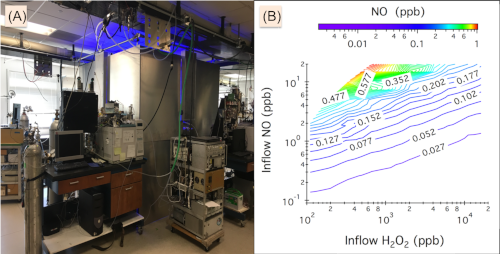2A: Steady State Continuous Flow Chamber
Experiments performed in laboratory chambers have contributed significantly to the understanding of the fundamental kinetics and mechanisms of the chemical reactions occurring in the atmosphere. Two chemical regimes, classified as ‘high-NO’ versus ‘zero-NO’ conditions, have been extensively studied in previous chamber experiments (e.g., Kroll and Seinfeld, 2008; Orlando and Tyndall, 2012; Ziemann and Atkinson, 2012). Results derived from these two chemical scenarios are widely parameterized in chemical transport models to represent key atmospheric processes in urban and pristine environments. As the anthropogenic NOx emissions in the United States have decreased remarkably in the past few decades, the classic ‘high-NO’ and ‘zero-NO’ conditions are no longer applicable to many regions that are constantly impacted by both polluted and background air masses.
The recently developed NCAR Atmospheric Simulation Chamber is operated in steady state continuous flow mode, with the goal of studying atmospheric chemistry under ‘intermediate NO’ conditions (Zhang et al., 2018). This particular chemical regime is characterized by constant sub-ppb levels of NO and can be created in the chamber by precise control of the inflow NO concentration and the ratio of chamber mixing to residence timescales. Characterization experiments under photolytic and dark conditions have been performed and, in conjunction with model predictions, provide a basis for interpretation of prevailing atmospheric processes in environments with intertwined biogenic and anthropogenic activities.

References
Kroll, J. H., and Seinfeld, J. H.: Chemistry of secondary organic aerosol: Formation and evolution of low-volatility organics in the atmosphere, Atmospheric Environment, 42, 3593-3624, 2008.
Orlando, J. J., and Tyndall, G. S.: Laboratory studies of organic peroxy radical chemistry: an overview with emphasis on recent issues of atmospheric significance, Chemical Society Reviews, 41, 6294-6317, 2012.
Ziemann, P. J., and Atkinson, R.: Kinetics, products, and mechanisms of secondary organic aerosol formation, Chemical Society Reviews, 41, 6582-6605, 2012.
Zhang, X., Ortega, J., Huang Y. L, Shertz S., Tyndall G. S., and Orlando, J. J.: A steady state continuous flow chamber for the Study of daytime and nighttime chemistry under atmospherically relevant NO levels, Atmospheric Measurement Techniques, 11, 2537-2551, 2018.
Contact
Please direct questions/comments about this page to:
Carl Drews
NSF NCAR | Research IT | ACOM